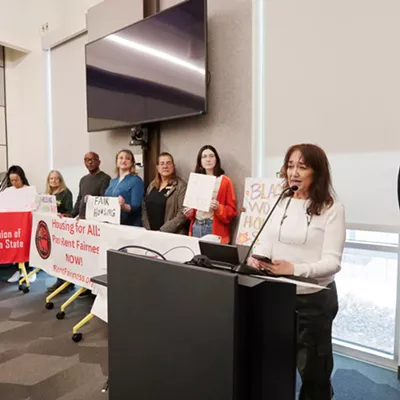And what do they reveal? Perched on the lip of each hole -- instead of a foil-wrapped chocolate -- sits a bright-yellow demolition bobcat with a scoop front and a wire cage to protect the operator. The holes also reveal that playing chicken with the city can be profitable -- if you have the right parcel of land.
Perhaps it's not a good sign that demolition gear is already in place -- hung for the dismantling with care -- even as the City Council dives headlong into the puzzling and intense fight to save two run-down buildings, the Rookery and the Mohawk.
The council on Monday was debating an 11th-hour proposal that the city purchase the two buildings for $4.75 million from owner Wendell Reugh and then sell them to developers who will refurbish the structures. A decision was not available at press time.
The three buildings known as the Rookery Block (the Rookery, the Mohawk and the now-demolished Merton) anchored the epicenter of downtown Spokane: the corner of Howard and Riverside. They don't all stand there any more, the Merton, oldest of the three, was taken down a year ago, and an entire block fronting Sprague Avenue now looks like a tooth has been pulled from the downtown skyline.
The Rookery and the Mohawk were to join the Merton in oblivion -- property owner Reugh has the demolition permit -- but the location, more than the historic value of the buildings, appears to provide the heat that has made this preservation fight so white hot. There have been protest marches, last-minute interventions, full-page newspaper ads and depictions of the publicly silent Reugh as some sort of Lucifer.
Big Plans, No Action & r & For years Reugh hoped to topple the old buildings for a high-rise office tower. Even though rumors of a skyscraper deal blew through downtown every few years, nobody seemed to have the oomph to pull off such a project.
So lately (lately being the last five or eight years), Reugh has announced he would drop the buildings, pave the footprint to make a parking lot and wait for the right deal on a skyscraper. It seemed to be just more talk until the Merton bit the dust. And even that seemed to be just more talk until the holes were punched into the side of the Rookery this month.
Sound the horns of panic.
Surface parking lots have spread like lesions across the face of downtown Spokane. Even though it's a ridiculous, inefficient use of land in an urban core, these parking lots, like smallpox scars, tend not to go away.
"How many times has a surface parking lot been turned into a building?" asks City Council President Dennis Hession, who has been driving the effort to save the Rookery and Mohawk.
"The only ones that come to mind for me are a couple of parking garages built by Walt Worthy," Hession says. "That's two in 30 or even 40 years."
When the economic development honchos begin to get up a head of steam, proposals for high-rises and condos and office towers begin to sprout from every surface parking lot. Downtown land is too valuable to simply dribble with 30-weight and antifreeze, the boosters say.
Hession notes, however, that some of these parking lots have been around since Expo '74.
"When they say there is going to be building, I say history does not bear that out. Will it be in 10 years? Twenty?" Hession asks.
He expresses mild interest in the architectural details of the Rookery and Mohawk, but adds, "I think the most important thing is the reality of what will happen to this site if we don't intervene. There will be a surface parking lot in the heart of the city."
A Line in the Sand & r & Advocates for preservation still mourn Reugh's demolition of the Merton last November, noting it was the oldest intact structure downtown -- built in 1890, just a year after the Great Fire, and a fine example of the Romanesque Revival style. The runty Rookery, erected in 1934, is a rare example of Art Deco, they say, and the taller Mohawk (1915) is a good example of Chicago School architecture.
Tenants who leased space in the buildings say they are nothing but worn-out heaps and should be torn down without shedding a tear.
Jonathan Swanstrom recounts the tale of his son and daughter-in-law, who were among the last tenants in the Rookery Building, running a vintage clothing operation that both sold retail in Spokane and in bulk to buyers from Japan.
The Rookery was attractive, Swanstrom writes in an e-mail, because it was cheap. The tradeoff, however, was "no heat, no hot water, no sprinkler system," Swanstrom adds.
The tradeoffs were bearable until a fire in November 1997 destroyed the business -- incinerating $30,000 worth of inventory on a day when the family, because of a funeral, came downtown several hours later than usual to open for business. The fire, Swanstrom recalls during an interview, was blamed on antiquated electrical systems. He said the only escape route went through the basement and ended at a locked iron door. The Inlander has made a public records request for the fire investigation report. The report was not obtained by press time.
Michael Moon Bear ran his West African drum shop out of street-level corner space in the Merton Building for years. Like the Swanstroms, he was attracted by the cheap rents in return for almost no amenities, such as heat.
"When I first moved down there, [Reugh's] dream was demolishing the building for a high-rise. Because of this, he put no money into maintenance," Moon Bear says. "It was nice being downtown -- something I considered part of my tradeoff. Towards the end, that didn't work any more. When it was raining outside, it was essentially raining inside my space, and there were days I just had to close."
Moon Bear's wasn't the only funky local business around the Rookery. "There was David's Pizza and Big Mamu," he says. There was Chicken N More, Britz Beads, Hill's Someplace Else.
"It was a lively little block for awhile," Moon Bear continues. "We offered local things that were interesting and fun. Go to any city that has a thriving downtown and it's a mix of chain things and a lot of local things that make it really fun. This is where Spokane is so lacking."
Good Deal or Not? & r & It remains to be seen if saving the Rookery will once again attract funky local businesses to a space they can afford. But Hession and City Councilman Joe Shogan say the city cannot afford a hole in the middle of downtown. The corner is already getting sketchy.
In recent years, Moon Bear says, the foot traffic around Howard and Riverside thinned as the "center" of downtown drifted west towards the Davenport district and River Park Square.
"People do like to preserve old buildings -- they are nice to have. They have the character and construction materials people can't afford any more," Moon Bear says. But the Rookery Block, of all the old buildings downtown, "doesn't seem very redeemable. I'm not sure what the agenda is."
Swanstrom is still steaming eight years after the fire that destroyed his son's business. He, too, wonders what the agenda is.
"Now Mr. Reugh wants to lock up a deal with the city of Spokane to dump his property on the taxpayers ... under the guise of historic preservation," Swanstrom writes. "If this is such a gold mine, where are the buyers? Wendell Reugh potentially put our lives in danger, and it was his fault by negligence we lost all of our inventory in the Rookery Building fire. Maybe he should settle with us first? It's just a fluke we weren't in there that day."
The city's involvement in the Rookery bailout has been roundly criticized as another River Park Square fiasco and as wasting money that could plug an estimated $6.8-million hole in the city's general fund. Hession says neither criticism is accurate. The city can't borrow to fill budget holes, he says, and the city will not keep the old buildings, but sell them quickly to developers who have been unable to work with Reugh.
"We don't like to see the city in the real estate business," says Ryan Romaneski of Spokane's Conover Bond, a development firm specializing in turning around old downtown buildings, "but this is a type of investment they should do. They are intermediaries with no plans to hold onto the property.
Even though Romaneski says the city's effort "is a matter of time and place" more than intrinsic historical value of the buildings, "You can't reproduce those types of buildings today. Once those doors are closed, they rarely open again."
Comments? Send them totheeditor@inlander.com
















